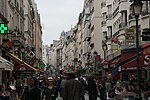Tour Jean-sans-Peur

The Tour Jean-sans-Peur or Tour de Jean sans Peur (English: Tower of John the Fearless), located in the 2nd arrondissement of Paris, is the last vestige of the Hôtel de Bourgogne, the residence first of the Counts of Artois and then the Dukes of Burgundy. The tower contained bed chambers and the grand stairway of the original residence, which stood next to it. It was completed between 1409–1411 by Jean sans Peur. The original hôtel occupied about a hectare of land, the boundaries of which are now marked by the rues Étienne Marcel, Montorgueil, Saint-Sauveur, and Saint-Denis. The tower itself is located at 20 rue Étienne Marcel, in the courtyard of an elementary school. It is one of the best surviving examples of medieval residential architecture in Paris. The tower is open to the public and presents changing expositions on life in the Middle Ages.
Excerpt from the Wikipedia article Tour Jean-sans-Peur (License: CC BY-SA 3.0, Authors, Images).Tour Jean-sans-Peur
Rue Étienne Marcel, Paris 2nd Arrondissement (Paris)
Geographical coordinates (GPS) Address Nearby Places Show on map
Geographical coordinates (GPS)
| Latitude | Longitude |
|---|---|
| N 48.864284 ° | E 2.34809 ° |
Address
École primaire
Rue Étienne Marcel
75002 Paris, 2nd Arrondissement (Paris)
Ile-de-France, France
Open on Google Maps







